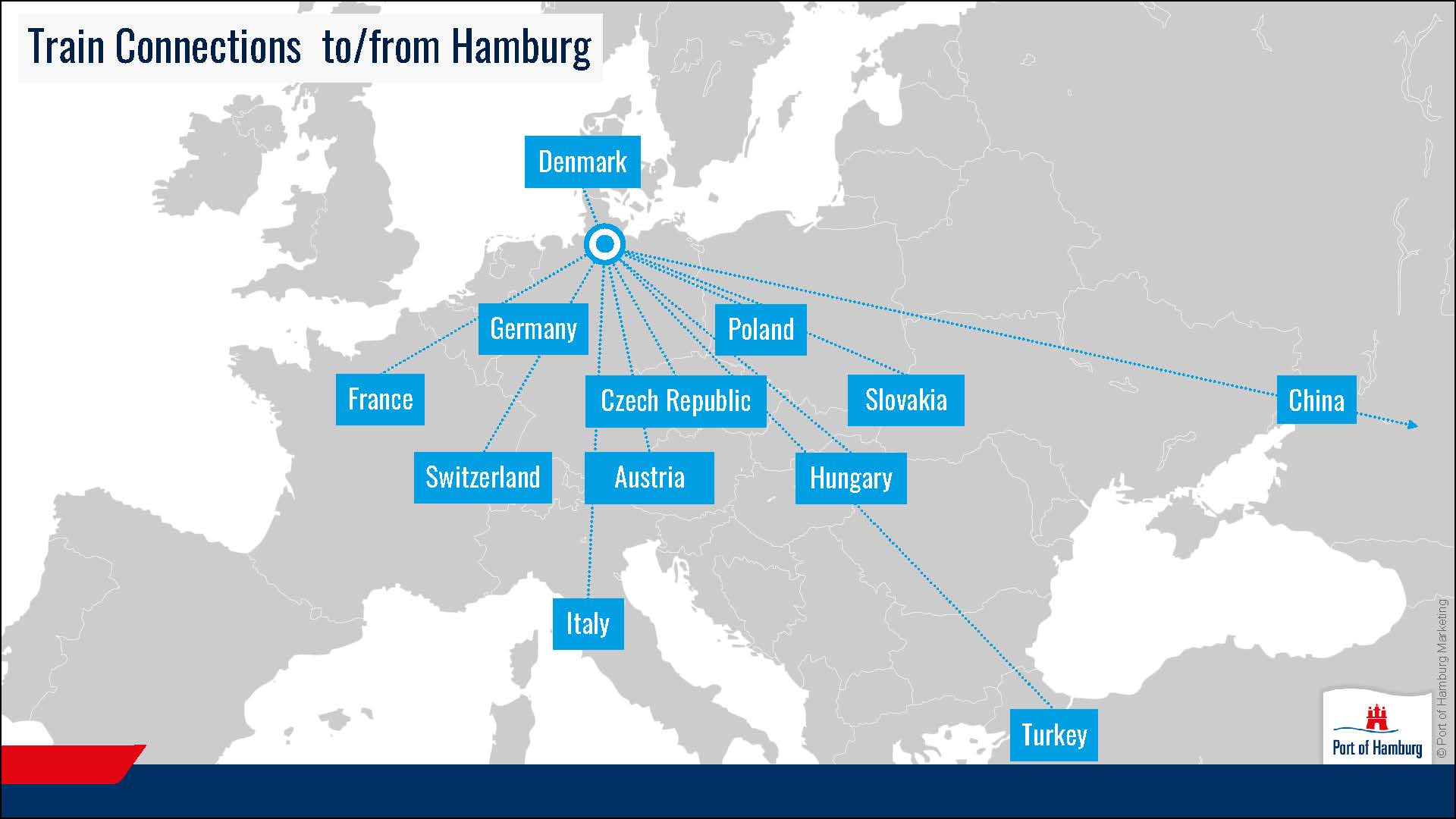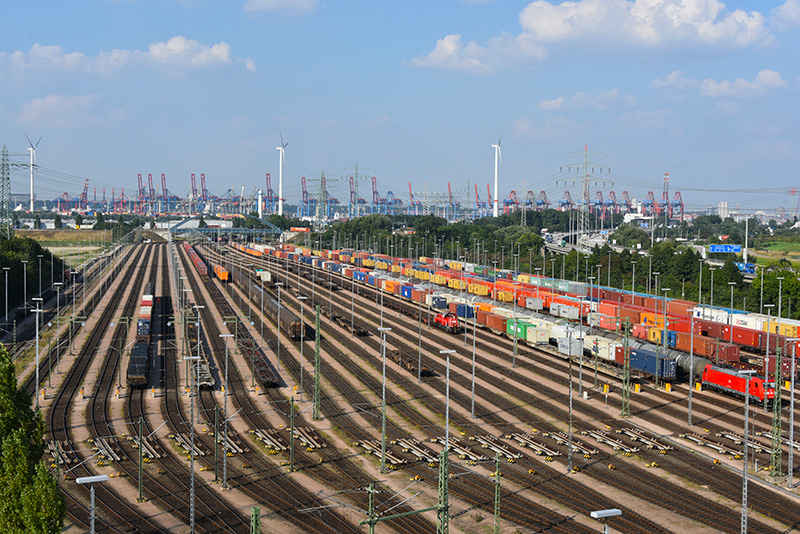In the Port of Hamburg 45,6 million tons were transported by rail in 2023. This strengthens the hanseatic city's position as leading rail port in Europe. The Port of Hamburg railway has a track network of about 300 kilometres, which efficiently handles around 200 goods trains with over 5,500 railcars daily. To ensure seamless rail traffic all container terminals have cutting-edge, high-performance handling facilities. Multi-purpose and bulk cargo terminals are also connected to the rail network.
Meanwhile more than 160 rail companies operate on the tracks in the Port of Hamburg. They offer a tightly-woven network of wagonload services, shuttle and block train connections throughout the whole of Europe.
Besides China, the Czech Republic, Austria and Poland are some of the most important international destinations for container train connections to and from the Port of Hamburg. The most important German states for transport volume in the German seaport hinterland services are Bavaria, Baden-Wuerttemberg, Saxony, Hesse and North Rhine-Westphalia.
An all-purpose port’s success rests on several factors. One of these is the quality of its hinterland infrastructure. For distances of above 300 kilometres, on many routes in Europe the systemic advantages of rail as a carrier hit gold when compared to trucking and inland waterway vessels: Rapidity, suitability for transport of large and compact volumes, value for money, reliability and environmental compatibility. A single 800-metre freight train can transport as much as some 50 trucks.
Trade and industry call for transport services causing less environmental impact. The Port of Hamburg has backed rail ever since the dawn of the railway age. Today it offers access to all terminals and industrial firms in the port via the Port Railway, founded in 1866. With total volume transported of 48 million tons, including 2.5 million TEU, the Port Railway takes top place among Europe’s ports. In public areas within the Port of Hamburg, the Port Railway owned by Hamburg Port Authority (HPA) operates the rail network. This extends around 300 kilometres, integrating 750 sets of points. An additional 120 kilometres of track are located in 80 private sidings owned by industrial, cargo handling and logistics companies.
The Port of Hamburg is immensely significant for German rail freight traffic. Hamburg is the source or destination for at least twelve percent of national rail freight traffic. Around 200 freight trains reach or leave the port on every working day. Bulk cargoes, containers and other freight are transported by rail. Day-to-day work in the port include block trains loaded with up to 6,600 tons of iron ore for steelworks in Salzgitter and Eisenhüttenstadt, and trainloads of potash salt from Werratal region bound for K+S’s Kalikai. Alltogether around 5,500 freight wagons use the Port Railway network every day.
DB Cargo is the largest provider of rail freight transport services. Besides, more than 160 registered rail operating companies meanwhile use the Port Railway network. These offer a tightly meshed network of wagonload services, and shuttle and block train links throughout Europe. Besides China, the Czech Republic, Austria and Poland are some of the most important international destinations for container train connections to and from the Port of Hamburg. The most important German states for transport volume in the German seaport hinterland services are Bavaria, Baden-Wuerttemberg, Saxony, Hesse and North Rhine-Westphalia..

In handling rail movements in the Port of Hamburg, loading centres and rail operators require access to transPORT rail, the Port Railway’s traffic management system. This forms the interface
for freight and data transport. Users can obtain access either through an interface or via the Internet (Web Client).
Via transPORT rail, users can:
To use transPORT rail, rail operators enter a contract with the Hamburg Port Authority that also regulates the fees. They can authorize their operators or service providers to process their transport data by granting them the appropriate authorization.

To enable rail and road traffic in the port to roll even more smoothly, in constructing new bridges HPA is pursuing the deliberate separation of transport modes and traffic flows. The new Rethe bascule bridge is just one exemplary project, replacing the Rethe lift bridge taken into service in 1934. The new structure will enter service in 2016. Separate wings will then be available for road and rail traffic. Being no longer required, the old lift bridge will then be removed. Taken into service in 1973, Kattwyk Lift Bridge is an additional example of separation of rail and road traffic. This is Germany’s largest lift bridge catering for both. In parallel to the bridge, which is 290 metres long and 90 metres high, a new, second bridge is to be built by the end of the decade. This will be reserved entirely for rail traffic.
Hamburg-Billwerder Terminal has a high reputation as a hub interlinking truck and rail, or what are primarily known as continental, intermodal road/rail transport services. Not least due to its geographical location, the terminal performs a growing number of other functions. It is not only an arrival and departure point for German and international shuttle trains, but also a significant rail/rail gateway terminal for international long-haul transport services. With what are known as short shuttle-trains, Hamburg-Billwerder also links the Baltic ports of Kiel, Lübeck and Rostock with the European intermodal network. For some maritime containers from the Port of Hamburg, the inland terminal also functions as an additional hub that enables these to reach the hinterland from Hamburg.